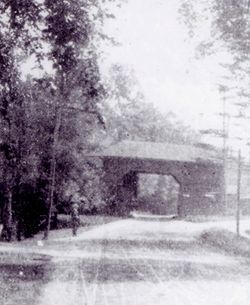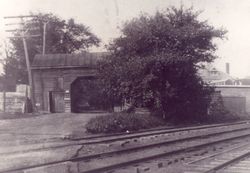Albany-Schoharie Plank Road
This page is a series of brief articles about the Albany-Schoharie Plank Road. The last article is followed by link to an in-depth article.
Photos, (cropped), courtesy of the Bethlehem Historical Society. The Slingerlands Tollgate on Slingerlands Ave. was demolished in 1908; it is now the site of the Tollgate Restaurant. The view looking west shows the railroad that was built basically parallel to the plank road; it provided a faster more comfortable ride, thus leading to the abandonment of the plank road.
Contents
NYS Historical Marker
There is a NYS Historical Marker in Altamont at the intersection of Main St. And Brandle Rd.: (Need picture, please.)
- Old Plank Road
- Schoharie to Albany
- Followed This Route
- Chartered 1849
- Abandoned 1867
Albany-Schoharie Plank Road
Altamont Enterprise, May 2, 1998; Laura Westfall, Wright town historian:
The Albany-Schoharie Plank Road company was incorporated [in 1849] with $70,000 in capital stock. Stocks were sold for $25 each. Road work was started in 1850. The road ran from Schoharie; east through the town of Wright and the town of Knox and Guilderland, reaching the Western Turnpike. The two mile branch running to Central Bridge made a total of 26 miles. The original cost was about $1,800 per mile.
To construct the road, six 4 x 4 hemlock sills were laid end to end and planks were lain crosswise. No nails were used. The edges of the road were left uneven to enable the wagons to pull to pass. The road was ten foot wide with an improved dirt road along the side. With no wood preservatives in use, the wood soon became rotten and had to be replaced about every five years, each time at a higher price. Timber was readily available from landowners along the way, thus cutting down on the cost of transporting lumber. Toll gates were located every five miles. There were five toll gates on this road.
The Albany-Schoharie Plank Road was extended through Warnerville, Richmondville, Summit and on to Charlotteville. The plank roads faded from the scene when Albany to Central Bridge Railroad became operational in 1863, providing much faster service than horse-powered vehicles. In May, 1866 the road lying east of Gallupville was abandoned. In April, 1867, the corporation was dissolved and the roadway was given to the towns.
from the History of Schoharie County
"History of Schoharie County, New York, 1713-1882: with illustrations and biographical sketches of some of its prominent men and pioneers", by William E. Roscoe, writing about the period about 1849:
The next object that absorbed the public mind throughout the County, as in other sections of the State, was the building of plank roads. It was not supposed possible to connect Schoharie with the outside world by iron ties " after so many efforts had proved failures, and the next best improvement was plank roads, in which large amounts of hard earned dollars were invested, to be trampled upon and slivered up without returning very flattering dividends.
One was built from Middleburgh, through Schoharie and Gallupville, to intersect the Western Turnpike nine miles from Albany, and one also from Schoharie to Richmondville, through Mineral Springs and Warnerville, also from Richmondville to Summit and Charlotteville. The road leading from Central Bridge to Schoharie was planked to intersect the Albany road at Fox's Creek. These roads were of the best when newly laid, but upon becoming worn were rough and uneven, making it wearisome for teams.
Not being very durable, replacing the plank and other natural expenditures made a continual expense, which the low tolls were insufficient to meet and which caused their abandonment in a few years. Covering the worn planks with pounded stone and gravel made excellent roads until the frost raised the planks to the surface, but the expense of keeping them in order satisfied capitalists of their inability to obtain paying dividends.
Schoharie Historical Review
The following article is from the Altamont Enterprise, Oct. 23, 1964:
Gregg Writes Story Of Schoharie Plank Road
The story of the old Albany and Schoharie Plank Road is the subject of the feature article carried in the Fall number of the official organ of the Schoharie County Historical society. The author is Arthur B. Gregg, Town Historian of Guilderland, who is also well known as an authority on Schoharie county history.
The plank road extended from Schoharie through the towns of Wright, Knox, Guilderland, to Albbany. Its life was short -- 1849 to 1867 — becoming a victim of the Albany and Susquehanna railroad (now the D. & H.). The very graphic story of its rise and fall is told by Mr. Gregg from original records he owns. The cover of the Historical Review carries a splendid cut of the original stagecoach that used to change its teams at the half-way tavern in Old Knowersville, now the home of Mr. and Mrs. William F. Bradt.
Copies of this valuable issue of the Schoharie Historical Review may be obtained from the curator of the Old Stone Fort, Myron Vroman, Schoharie, at 75 cents a copy.
The Albany, Rensselaerville, and Schoharie Plank Road
By Susan E. Leath, Town of Bethlehem Historian (with permission)
Throughout the 1800’s road development was a private undertaking. The state legislature established laws regulating the formation of corporations to develop and maintain turnpikes and later plank roads. The Albany to Schoharie Plank Road, the modern day New Scotland Avenue, was the result of a corporation purchasing the necessary land, constructing the road and then collecting the tolls. A plank road was just that, wood planks were laid over a dirt road to provide a smooth ride. The days of the plank roads were limited. Maintenance proved costly as the wood began deteriorating after a few years. Legislated in 1847, they were gone by 1860.
Other toll roads in Bethlehem include The Albany and Bethlehem Turnpike, The Albany and Delaware Turnpike, the Green County and Albany Turnpike, the South Bethlehem Plank Road and the Albany and Clarksville Plank Road. Can you guess what these roads are called today?
All of these turnpikes and plank roads featured tollgates where fares were collected. Typical fares were five cents for a one horse rig and ten cents for a team or load. Some people didn’t have to pay, including those going to religious meetings, funerals, and town meetings. Even with these exceptions, people still tried to avoid paying the toll by “shunpiking” or driving around the toll.
The Old Albany and Schoharie Plank Road
The Old Albany and Schoharie Plank Road is a detailed history of the road written by Miss Mary Gregg of Altamont in 1932 for her graduation essay topic. Thoroughly researched, it has fascinating facts as well as many reminiscences by then elderly folk who remembered the road in its hay day. Especially riveting is the story of the night the 134th Reg. of N. Y. S. Volunteers camped over night near the Keenholts Hotel in Knoweresville, (now Altamont) when they marched down the plank road from Schoharie enroute to Albany and Gettysburg. Here is a brief excerpt from her essay as printed in the Altamont Enterprise, August 12, 1932:
"Webb" Whipple, who as a little boy lived in old Knowersville, states, "that on the 22nd day of Sept. 1862 I was down at Cold Spring near the Bozenkill gathering butternuts where you kids do today. Suddenly I heard a sound of music and hurrying up to the old plank road saw the soldiers from Schoharie coming over the hill. There were about 80 less than their full 1000 for a regiment. With them were their ambulance and commissary trains. Behind followed riding in every conceivable conveyance their women folks and children. In the fields about Knowersville they camped for the night. Everyone in the neighborhood depleted his larder to feed the Schoharie soldiers. As dark came on they simply rolled up in blankets all over the fields as the weather was quite warm. I can remember how my mother's heart went out to the women and children who had come thus far to be with their loved ones and now were crying and sobbing. Some of the men were stoic. Quite a few got drunk and eight men deserted. In the morning they marched down the plank road to Albany and from there by boat to New York. The tears of the women at old Knowersville were indeed prophetic and the fields of Chancellorsville, Gettysburg and Missionary Ridge ran red with the blood of their husbands and fathers."
- And now for the rest of the story click on The Old Albany and Schoharie Plank Road

